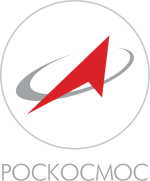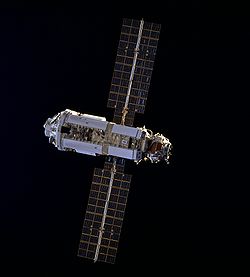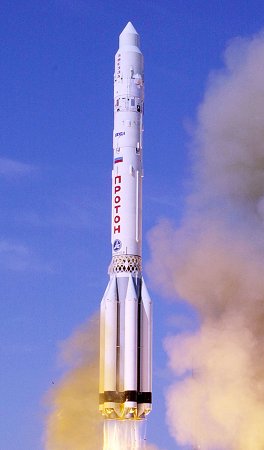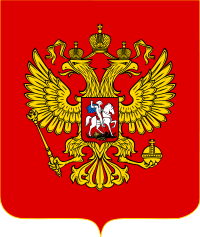Russian Federal Space Agency
 Logo of Roscosmos |
|
| Established | 1992 (formerly the Soviet space program, 1922-1991) |
|---|---|
| Headquarters | Moscow |
| Primary spaceport | Baikonur Cosmodrome Plesetsk Cosmodrome |
| Administrator | Anatoly Perminov |
| Budget | 82 billion RUB ($2.4 billion) (2009)[1] |
| Website | www.roscosmos.ru |
The Russian Federal Space Agency (Russian: Федеральное космическое агентство России Federal'noye kosmicheskoye agentstvo Rossii), commonly called Roscosmos (Роскосмос Roskosmos) and abbreviated as FKA (ФКА) and RKA (РКА), is the government agency responsible for the Russian space science program and general aerospace research. It was previously the Russian Aviation and Space Agency (Russian: Российское авиационно-космическое агентство Rossiyskoe aviatsionno-kosmicheskoe agentsvo, commonly known as "Rosaviakosmos").
Headquarters of Roscosmos are located in Moscow. Main Mission Control space flight operations center is located in a nearby city of Korolev. Cosmonauts Training Centre (GCTC) is in Star City. Launch facilities used are Baikonur Cosmodrome in Kazakhstan (with most launches taking place there, both manned and unmanned) and Plesetsk Cosmodrome in northern Russia used primarily for unmanned flights of military designations.
Since his appointment as General Director in March 2004, Anatoly Perminov has led Russia's efforts to consolidate its space program.
Contents |
History
the first satellite, Sputnik 1 (a ball under the ceiling);
the first spacesuits (lower-left corner);
the first human spaceflight module, Vostok 1 (center);
the first Molniya-type satellite (upper right corner);
the first space rover, Lunokhod 1 (lower right corner);
the first space station, Salyut 1 (left);
the first modular space station, Mir (upper left).
The Soviet space program did not have central executive agencies. Instead, its organizatorial architecture was multi-centered; it was the design bureaus and the council of designers that had the most say, not the political leadership. The creation of a central agency after the separation of Russia from the Soviet Union was thus a new development. Russian Space Agency was formed on 25 February 1992 by a decree of President Yeltsin. Yuri Koptev, who had previously worked with designing Mars landers at NPO Lavochkin, became the agency's—later renamed to Roskosmos—first director.[2]
In the early years, the agency suffered from lack of authority as the powerful design bureaus fought to protect their own spheres of operation and to survive. For example, the decision to keep Mir in operation beyond 1999 was not taken by the agency; instead, it was made by the private shareholder board of the Energia design bureau. Also, the development of the new Angara rocket was a function of Krunichev's ability to attract resources rather than a conscious long-term decision by the RKA.[2]
The 1990s saw serious financial problems because of the decreased cash flow, which encouraged Roskosmos to improvise and seek other ways to keep space programs running. This resulted in Roskosmos' leading role in commercial satellite launches and space tourism. While scientific missions, such as interplanetary probes or astronomy missions during these years played a very small role, Roskosmos managed to operate the space station Mir well past its planned lifespan, contribute to the International Space Station, and continue to fly additional Soyuz and Progress missions.
In March 2004, director Yuri Koptev was replaced by Anatoly Perminov, who had previously served as the first commander of the Space Forces.[2]
Renewed activity in 2005–2006
The Russian economy boomed throughout 2005 from high prices for exports, such as oil and gas, the outlook for future funding in 2006 appeared more favorable. This resulted in the Russian Duma approving a budget of 305 billion rubles (about 11 billion USD) for the Space Agency from 2006 to 2015, with overall space expenditures in Russia total about 425 billion rubles for the same time period.[3] The budget for 2006 was as high as 25 billion rubles (about 900 million USD), which is a 33% increase from the 2005 budget. Under the current 10 year budget approved, the budget of the Space Agency shall increase 5–10% per year, providing the space agency with a constant influx of money. In addition to the budget, Roskosmos plans to have over 130 billion rubles flowing into its budget by other means, such as industry investments and commercial space launches.
Current status of the space program
The federal space budget for the year 2009 was left unchanged despite the global economic crisis, standing at about 82 billion rubles ($2.4 billion).[1] Current priorities of the Russian space program include the new Angara rocket family and development of new communications, navigation and remote Earth sensing spacecraft.[1] The GLONASS global navigation satellite system has for many years been one of the top priorities and has been given its own budget line in the federal space budget. In 2007, GLONASS received 9.9 billion rubles ($360 million), and under the terms of a directive signed by Prime Minister Vladimir Putin in 2008, an additional $2.6 billion will be allocated for its development.[4]
Due to International Space Station involvements, up to 50% of Russia's space budget is spent on the manned space program. Some observers have pointed out that this has a detrimental effect on other aspects of space exploration, and that the other space powers spend much lesser proportions of their overall budgets on maintaining human presence in orbit.[5]
The Russian space program benefits from a considerable amount of investments made during the Soviet era, including technology and launch sites. The launch sites are located mostly in the country of Kazakhstan and are maintained and utilized in cooperation with the government of Kazakhstan. The RKA has centralized control of Russia's civilian space program, including all manned and unmanned non-military space flights.
Despite the considerably improved budget, attention of legislative and execute authorities, positive media coverage and broad support among the population, the Russian space program continues to face several problems.[6] Wages in the space industry are low; the average age of employees is high (46 years in 2007),[6] and much of the equipment is obsolete.[7] On the positive side, many companies in the sector have been able to profit from contracts and partnerships with foreign companies; several new systems such as new rocket upper stages have been developed in recent years; investments have been made to production lines, and companies have started to pay more attention to educating a new generation of engineers and technicians.[2][7]
The federal space plan for 2006–2015
The key elements of the current space plan, introduced in 2005, are:[2]
- Replacement of the Soyuz spacecraft: Prospective Piloted Transport System
- New rocket for manned flights: Rus-M
- Return to Moon: Luna Glob (launch of the first probe planned for 2012)
- Return to Mars: Phobos Grunt (scheduled for launch in 2011)
- Return to Venus: Venera D
- Mars 500 simulation (under way in 2009)
- Introduction of the Angara launcher (first launch expected in 2011)
- Completion of the Russian segment of the International Space Station
- Completion of the GLONASS group to 18 operational satellites by end of 2007
- New Earth resources programs using the Resurs DK platform: Resurs P (2009) and Smotr (2007) and a small platform Arkon (2007)
- Earthquake monitoring satellite Vulkan (2007)
- New science missions: Koronas Foton (launched in January 2009), Spektr R (Radioastron, 2007), Spektr RG (Radio Gamma, 2009) and Spektr UV (Ultra Violet, 2010), Intergelizond (2011), Venera D (2016), Celsta (2018) and Terion (2018)
- Resumption of Bion missions with Bion M (2010)
- New weather satellites Elektro L (2007) and Elektro P (2015)[2]
Current programs
ISS involvement

The Russian Space Agency is one of the partners in the International Space Station (ISS) program; it contributed the core space modules Zarya and Zvezda, which were both launched by Proton rockets and later were joined by NASA's Unity Module. The Rassvet module was launched aboard Space Shuttle Atlantis[8] and will be primarily used for cargo storage and as a docking port for visiting spacecraft. The Nauka module will be the last compnent of the ISS and is expected to launch December 2011.[9][10] Roskosmos is furthermore responsible for expedition crew launches by Soyuz-TMA spacecrafts and resupplies the space station with Progress space transporters. After the initial ISS contract with NASA expired, RKA and NASA, with the approval of the US government, entered into a space contract running until 2011, according to which Roskosmos will sell NASA spots on Soyuz spacecrafts for approximately $21 million per person each way (thus $42 million to and back from the ISS per person) as well as provide Progress transport flights ($50 million per progress as outlined in the Exploration Systems Architecture Study study [1]). RKA has announced that according to this arrangement, manned Soyuz flights will be doubled to 4 per year and Progress flights also doubled to 8 per year beginning in 2008.
RKA also provides space tourism for fare-paying passengers to ISS through the Space Adventures company. As of 2009, six space tourists have contracted with Roskosmos and have flown into space, each for an estimated fee of at least $20 million (USD).
Science programs
RKA operates a number of other programs for earth science, communication, and scientific research. Future projects include the Soyuz successor, the shuttle Kliper, scientific robotic missions to one of the Mars moons as well as an increase in Earth orbit research satellites.
- Luna-Glob Moon orbiter with penetrators
- Venera-D Venus lander
- Phobos-Grunt Mars mission
Rockets
Roskosmos is using a launch family of several rockets, the most famous of them is the R-7, commonly known as the Soyuz rocket, capable of launching about 7.5 tons into low Earth orbit (LEO). The Proton rocket (or UR-500K) has a lift capacity of over 20 tons to LEO. Smaller rockets include Cosmos-3M, the German-Russian cooperation Rockot and other launchers.
Currently rocket development encompasses both a new rocket system, Angara, as well as enhancements of the Soyuz rocket, Soyuz-2 and Soyuz-2-3. Two modifications of the Soyuz, the Soyuz-2.1a and Soyuz-2.1b has already been successfully tested, enhancing the launch capacity to 8.5 tons to LEO.
RKA manages by far the most commercial launches per year, in 2005 it performed nearly 50% of all commercial satellite launches into space.
Kliper
One of RKA's projects that has made a large impact on the media in 2005 is Kliper, a small lifting body reusable spacecraft. While Roskosmos has reached out to ESA and JAXA as well as others to share development costs of the project, it also has stated that it will go forward with the project even without support of other space agencies. This statement was backed by the above-described approval of its budget for 2006–2015, which includes the necessary funding of Kliper.
Information on Kliper's entry into service and development status vary. Some sources state 2010 as the target year of first orbital test flight, others, 2012. In January 2006, the final decision on Kliper was anticipated to be made from among three proposals from several Russian contractors with a decision to be announced in February. Later, the result of formal bidding on the project was expected to be revealed in July. However, RKA reportedly issued a statement in late July that bidding for the Kliper program had been cancelled due to the insufficiency of the bids tendered. It was believed that there would a two-year period within which the future direction of the program would be determined.
Launch control
The military counterpart of the RKA is the Military Space Forces (VKS). The VKS controls Russia's Plesetsk Cosmodrome launch facility. The RKA and VKS share control of the Baikonur Cosmodrome, where the RKA reimburses the VKS for the wages of many of the flight controllers during civilian launches. The RKA and VKS also share control of the Yuri Gagarin Cosmonaut Training Center. It has been announced that Russia is to build another spaceport in Vostochny. The Vostochny Cosmodrome is scheduled to be finished by 2018.
Historic Russian space gallery
People
 First human in space Yuri Gagarin |
Spacecraft
 Vostok was the first spacecraft to carry a human being in space |
 Soyuz is the longest serving manned spacecraft design in history (1967– ) , upgraded regularly |
 Progress is the longest serving unmanned cargo spacecraft (1978– ) |
 First permanently manned space station, the Soviet/Russian Mir, which orbited the Earth from 1986 until 2001 |
|
The Soviet space program produced the Space Shuttle Buran based on the Energia launcher. Energia would be used as the base for a manned Mars mission. On November 15, 1988, as snowy clouds and winds were swirling around Baikonur Cosmodrome in Kazakhstan, the Buran orbiter, attached to its giant Energia rocket, thundered into the gloomy early morning sky. Three hours and two orbits later, the 100-tonne bird glided back to a flawless landing just a few miles from its launch pad and just 3m off the runway centreline.) |
Launch vehicles
 Soyuz rockets are responsible for launching all Soyuz and Progress spacecraft into space |
 Proton rockets are the heavylift workhorse of Russian space industry |
References
- ↑ 1.0 1.1 1.2 "No cut in Russian 2009 space spending, $2.4 bln on 3 programs". RIA Novosti. 2009-03-18. http://en.rian.ru/russia/20090318/120627935.html. Retrieved 2009-08-23.
- ↑ 2.0 2.1 2.2 2.3 2.4 2.5 Harvey, Brian (2007). "The design bureaus". The Rebirth of the Russian Space Program (1st ed.). Germany: Springer. ISBN 9780387713540.
- ↑ Russian govt agrees 12.5 bln eur 10-yr space program - Forbes.com
- ↑ "Russia increases number of operational Glonass satellites to 17". RIA Novosti. 2009-06-04. http://en.rian.ru/russia/20090604/155166861.html. Retrieved 2009-08-23.
- ↑ Afanasyev, Igor; Dmitri Vorontsov (2009-11-01). "Building on sand?The Russian ISS segment is to be completed by 2016". Russia & CIS Observer. http://www.ato.ru/content/building-sand. Retrieved 2010-01-03.
- ↑ 6.0 6.1 "Russia’s Space Program in 2006: Some Progress but No Clear Direction". Moscow Defense Brief. 2006. http://mdb.cast.ru/mdb/2-2007/item1/item3/. Retrieved 2009-08-23.
- ↑ 7.0 7.1 Kislyakov, Andrei (2008-05-15). "Russian space program bedeviled by problems". http://en.rian.ru/analysis/20080515/107469026.html. Retrieved 2009-08-23.
- ↑ Chris Gebhardt (9 April 2009). "STS-132: PRCB baselines Atlantis' mission to deliver Russia’s MRM-1". NASAspaceflight.com. http://www.nasaspaceflight.com/2009/04/sts-132-prcb-baselines-mission-to-deliver-russias-mrm-1/. Retrieved 12 November 2009.
- ↑ "Consolidated Launch Manifest". nasa.gov. 2010. http://www.nasa.gov/mission_pages/station/structure/iss_manifest.html. Retrieved April 26, 2010.
- ↑ Roscosmos - December 31,2009
External links
See also
- Timeline of Russian inventions and technology records
|
|||||||||||||||||||||||||||||||||||||||||||||||
|
|||||||||||||||||
|
|||||||||||
|
|||||||||||
|
||||||||||||||||||||||||||||||||||||||||||||||||||||||||||


